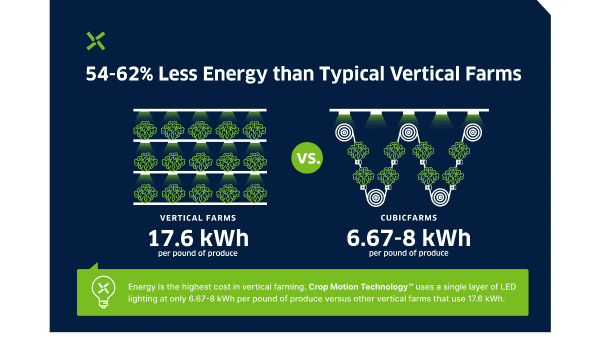VANCOUVER, BC, May 12, 2022 /PRNewswire/ – CubicFarm Systems Corp., a leading local chain agricultural technology company, today announced new data that demonstrates 54% to 62% less energy is used in a CubicFarm System module compared to results reported by other vertical farms surveyed globally.
With electricity being the number one input cost in vertical farming, this is a significant advantage to customers using the CubicFarm System technology for indoor growing.
Most vertical farming operations rely on light emitting diode (“LED”) grow lights positioned above every row of plants. Despite the significant land, water, and labour benefits of year-round indoor growing, the high energy usage of LED grow lights has, until now, slowed the wider adoption of Controlled Environment Agriculture.
In 2020, the global vertical farming market was estimated at $3.24 billion and is expected to reach $24.11 billion by 2030¹. The world’s leading advisory firm on urban and controlled environment agriculture, Agritecture, highlighted the need for greater transparency and accountability for claims about energy use in the vertical farming sector in its 2021 Global CEA Census Report.
“Lighting accounts for 65% of energy usage in a typical indoor farming operation,” reported Henry Gordon-Smith, Founder and Chief Executive Officer, Agritecture. “62% indicated that they track energy consumption, but only 28% provided a credible number. Reporting how growers measure specific ESG (environmental, social, and governance) outcomes provides much needed and valuable insights that affect new technology adoption rates, policies, financing, and global operations. We’re pleased to see CubicFarms taking a leadership role in benchmarking and sharing its significant energy savings.”
The Company initiated new data collection to effectively measure energy usage in the CubicFarm System. Patented Crop Motion Technology™ moves plants to one layer of LED grow lights, unlike typical rack and stack layouts of other vertical farms that use multiple layers of energy-intensive LEDs. Findings include:
- 17.6 kilowatt hours (“kWh”) per pound in typical vertical farms²
- 8 kWh/pound in a CubicFarm System module (54% less than typical vertical farms)
- 6.67 kWh/pound in a CubicFarms FreshHub System (62% less than typical vertical farms)
The Company’s high-density FreshHub with 96 modules benefits from improved efficiencies of the growing system, using 62% less energy than typical vertical farms at 6.67 kWh/pound.
“The new data clearly demonstrates that a CubicFarm System is the most energy-efficient way to grow fresh produce indoors,” said Edoardo De Martin, President and Chief Technology Officer, CubicFarms. “The high cost and energy requirements of thousands of LEDs is inefficient when automation allows us to use just a single layer. This industry comparison proves the definitive energy savings for our Farmer Partners growing produce using a CubicFarm System.”
“At CubicFarms, we’re committed to providing much-needed transparency in the ag-tech industry,” said Dave Dinesen, Chief Executive Officer, CubicFarms. “We’re in a category of our own with Crop Motion farming challenging the industry and creating the gold standard with the lowest energy requirements in vertical farming. CubicFarms’ pioneering technology was initially developed by one of North America’s largest greenhouse plant propagation businesses, Bevo Farms. We’re leveraging decades of indoor growing experience and our innovative Crop Motion Technology™ to show that we’re closer to the minimal energy requirements of greenhouse growing using solar energy. Other vertical farms require two to three times more energy than a CubicFarm System.”
According to self-reported data surveyed and compiled in Agritecture’s 2021 Global CEA Census Report, greenhouse operations require an average of 2.5 kilowatt hours of energy per pound of produce grown. CubicFarms’ indoor growing technology is significantly closer to the low energy consumption typical of greenhouse growing using solar energy. Greenhouse growing requires more land and water than vertical farms, while CubicFarms’ FreshHub System occupies one acre and replaces 100 acres of outdoor growing.
“CubicFarm System modules and FreshHubs can be located near major population centres for closer access to more reliable, year-round growing indoors with the added flexibility of less land, less water, localized transportation, and significant energy savings,” said Dinesen.
¹Allied Market Research https://www.alliedmarketresearch.com/vertical-farming-market.
²Agritecture 2021 Global CEA Census Report, Typical Vertical Farm Energy Usage https://www.agritecture.com/census.
About CubicFarms
CubicFarms is a leading local chain agricultural technology company developing and deploying technology to feed a changing world. Its proprietary ag-tech solutions enable growers to produce high quality, predictable produce and fresh livestock feed with HydroGreen Nutrition Technology, a division of CubicFarm Systems Corp. The CubicFarms™ system contains patented technology for growing leafy greens and other crops onsite, indoors, all year round. CubicFarms provides an efficient, localized food supply solution that benefits our people, planet, and economy.
For more information, please visit www.cubicfarms.com.



